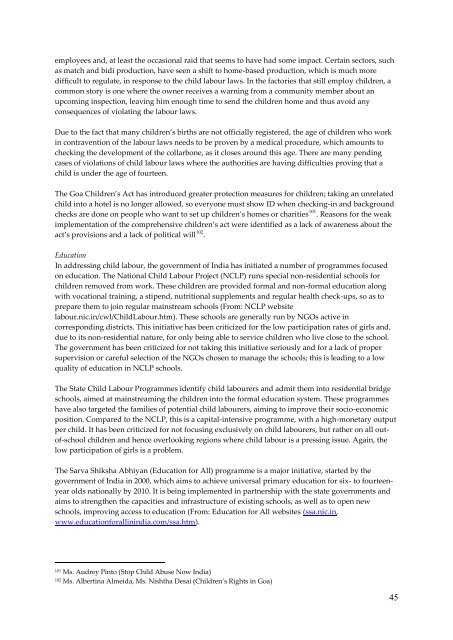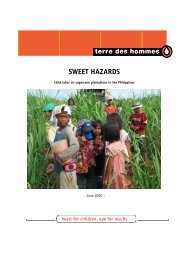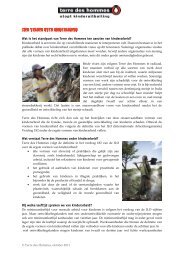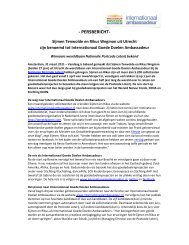Untitled - Terre des Hommes
Untitled - Terre des Hommes
Untitled - Terre des Hommes
- No tags were found...
You also want an ePaper? Increase the reach of your titles
YUMPU automatically turns print PDFs into web optimized ePapers that Google loves.
employees and, at least the occasional raid that seems to have had some impact. Certain sectors, such<br />
as match and bidi production, have seen a shift to home-based production, which is much more<br />
difficult to regulate, in response to the child labour laws. In the factories that still employ children, a<br />
common story is one where the owner receives a warning from a community member about an<br />
upcoming inspection, leaving him enough time to send the children home and thus avoid any<br />
consequences of violating the labour laws.<br />
Due to the fact that many children’s births are not officially registered, the age of children who work<br />
in contravention of the labour laws needs to be proven by a medical procedure, which amounts to<br />
checking the development of the collarbone, as it closes around this age. There are many pending<br />
cases of violations of child labour laws where the authorities are having difficulties proving that a<br />
child is under the age of fourteen.<br />
The Goa Children’s Act has introduced greater protection measures for children; taking an unrelated<br />
child into a hotel is no longer allowed, so everyone must show ID when checking-in and background<br />
checks are done on people who want to set up children’s homes or charities 101 . Reasons for the weak<br />
implementation of the comprehensive children’s act were identified as a lack of awareness about the<br />
act’s provisions and a lack of political will 102 .<br />
Education<br />
In addressing child labour, the government of India has initiated a number of programmes focused<br />
on education. The National Child Labour Project (NCLP) runs special non-residential schools for<br />
children removed from work. These children are provided formal and non-formal education along<br />
with vocational training, a stipend, nutritional supplements and regular health check-ups, so as to<br />
prepare them to join regular mainstream schools (From: NCLP website<br />
labour.nic.in/cwl/ChildLabour.htm). These schools are generally run by NGOs active in<br />
corresponding districts. This initiative has been criticized for the low participation rates of girls and,<br />
due to its non-residential nature, for only being able to service children who live close to the school.<br />
The government has been criticized for not taking this initiative seriously and for a lack of proper<br />
supervision or careful selection of the NGOs chosen to manage the schools; this is leading to a low<br />
quality of education in NCLP schools.<br />
The State Child Labour Programmes identify child labourers and admit them into residential bridge<br />
schools, aimed at mainstreaming the children into the formal education system. These programmes<br />
have also targeted the families of potential child labourers, aiming to improve their socio-economic<br />
position. Compared to the NCLP, this is a capital-intensive programme, with a high-monetary output<br />
per child. It has been criticized for not focusing exclusively on child labourers, but rather on all outof-school<br />
children and hence overlooking regions where child labour is a pressing issue. Again, the<br />
low participation of girls is a problem.<br />
The Sarva Shiksha Abhiyan (Education for All) programme is a major initiative, started by the<br />
government of India in 2000, which aims to achieve universal primary education for six- to fourteenyear<br />
olds nationally by 2010. It is being implemented in partnership with the state governments and<br />
aims to strengthen the capacities and infrastructure of existing schools, as well as to open new<br />
schools, improving access to education (From: Education for All websites (ssa.nic.in,<br />
www.educationforallinindia.com/ssa.htm).<br />
101<br />
Ms. Audrey Pinto (Stop Child Abuse Now India)<br />
102<br />
Ms. Albertina Almeida, Ms. Nishtha Desai (Children’s Rights in Goa)<br />
45













